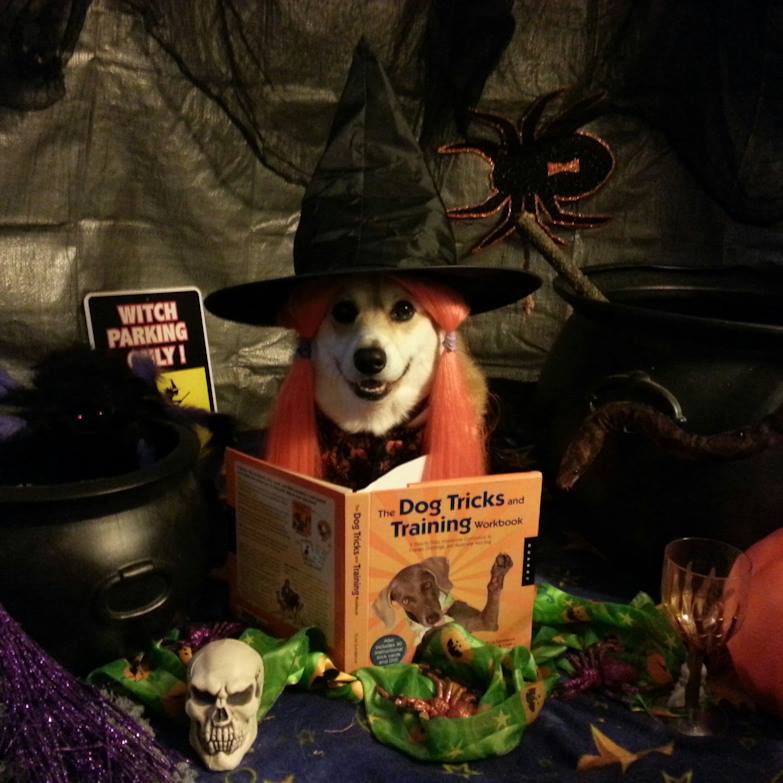
Should your dog go trick-or-treating with you?
Probably not.
There are exceptions, of course. I know adults who love to dress their dogs in costumes and—because the humans have made sure that being dressed up has been consistently rewarding for the dogs—the dogs like it, too. That is probably a very small percentage of dogs, since a very small percentage of owners take the time and effort to accustom their dogs to dressing up.
If you haven’t done the training and you’re not sure your dog is comfortable in an outfit, don’t dress him up in an outfit, especially on an occasion when everyone is over-excited already.
Would the dog be comfortable without a costume, going trick-or-treating with your family? It’s possible, certainly, that a mature dog who walks every day with her humans would enjoy that walk even on a night when everyone is dressed strangely and over-amped on sugar. But remember, taking a dog out on Halloween night is asking for random children and adults to approach her without warning and to pet her without asking, probably not in the gentlest manner. You’d best be sure your dog won’t be frightened or annoyed by the unusual attention. If you’re not sure, don’t take the dog with you.
Should your dog greet trick-or-treaters at the door?
Mature confident dogs who don’t bark or jump up might be allowed to greet trick-or-treaters at the front door—on leash only, please, no flexible leads—as long as you have one adult to handle the dog while someone else passes out the candy. Small dogs might be more comfortable greeting guests while being held securely by an adult . . . but only if being held doesn’t make them nippy or growly.
Again, dogs allowed to greet visitors at the door are fair game for petting—even grabbing and hugging. If your dog is not completely at ease with awkward physical attention, keep him inside the door. If necessary, block access by stepping between him and the children.
Quit long before the dog gets tired or cranky, take him to a room away from the front door, and crate him with a chew treat.

Photo by Susan Brogan
What about pets who won’t be greeting trick-or-treaters?
Create a safety “air lock” around your front door. If you don’t have doors to close off the area, use pet-safe baby gates or leave the pet behind a closed door somewhere else in the house. I would rather have my cat displeased with me for the evening than risk her running out the front door when I open it for trick-or-treaters! Crate your dog with a frozen Kong, appease your cat with a catnip toy; play music or leave the TV on to mask outside noises.
Plan ahead.
▪ Don’t be so rushed with preparations for the night’s festivities that you forget to take Fido outside early, preferably before dark, to “do his business” before the youngest visitors arrive.
▪ Consider keeping your indoor-outdoor cat in overnight on October 30 and October 31, for safety’s sake.
▪ Double-check your pocket pets, reptiles, birds, and so on. Be sure they’re well secured in their cages—behind closed doors, if possible.
▪ If you care for feral cats, consider moving their feeding area away from the front of your house where trick-or-treaters pass by. Ideally, close them in a secure safe area like a garage or garden shed for Halloween night, at least. (Contact local animal control or humane agencies about live-trapping the ferals so they can be neutered and vetted, and possibly placed in farm homes.)
▪ Candles, pumpkins, or candy in your home or part of your indoor or outdoor decorations? Be sure to secure any lit or edible items well out of pets’ reach.
▪ Continue to be vigilant about keeping the candy secure until it’s all gone. Don’t leave it lying around anywhere that your dog (or any other pet) can get to it. Even the wrapping can be dangerous, and too much candy can cause a very sick pet and very high vet bills!
Dogs can join in the Halloween fun with a very simple game: bobbing for treats! Pour a few inches of cool water into a dishpan (for larger dogs) or bowl (for smaller dogs), drop in some dog biscuits, and encourage Fido to “dive” for—and eat—the treats. Add more water if Fido sticks his muzzle in it; use towels under the pan or bowl if you’re concerned about water on the floor—and be prepared to dry off Fido should he get enthused about the game. More than one dog? Have them take turns.
Are you expecting neighborhood dogs to trick-or-treat at your house? Make some special doggy treats!
▪ Wash sweet potatoes or yams and slice them very thin.
▪ Spread the slices on a cookie sheet.
▪ Bake at 250 degrees for three to four hours (depending on thickness), flipping once an hour until they’re done.
▪ Cool.
Ask the kids to decorate small baggies with stickers or markers, then distribute these healthy home-made treats to your closest doggy friends.
When it’s time to turn in on Halloween night, don’t send your dog out alone to “do his business.” Go with him or stand where you can see him, with yard lights or a flashlight. In an unfenced yard, keep Fido on a long line. For dogs that must be walked, don’t walk alone; ask a friend to join you . . . because it’s Halloween. Be safe, not sorry.
Get you and Fido back inside so you can sleep until November!



